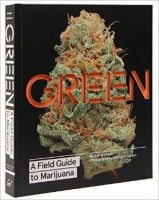
Most stoners have probably seen Jason King’s The Cannabible, probably all three in the collection. “What a wonderful job,” many a stoner has certainly muttered, wishing that our job was to photograph (and sample) the best cannabis in the world. Following in the the footsteps of Mr. King are Erik Christiansen and Dan Michaels, who have captured great shots of a variety of strains in Green: A Field Guide to Marijuana. NPR spoke with the Mr. Christiansen about his beautiful coffee-table book:
Seeing the buds close up accentuates the variations — some have these wiry golden threads and others are tightly coiffed, like beehive hairdos. They seem to take on personalities. What does this tell us about the plants?
You can take the same plant and give a clone to six different growers and at the end of that grow cycle each will be unique in its own way, based on the nutrients that the growers us, the CO2 content of the air and the temperature of the room. Being able to get up close and see those differences is important.
If you look at any of the pictures, there are these little balls on the end of each plant— that’s where the THC is stored. The more little balls, or trichomes, that are present on the buds, the more potent it can be. The color will also tell you a lot about the effect it will deliver. More amber-color trichomes will deliver a more body effect, where lighter-colored trichomes will be more of a head-y effect.
The book looks great and it seems like the creators put a lot of time into “researching” the strains (tough job that somebody has to do.) I look forward to checking out the bud porn and reading about the multitude of strains currently available. This is a book that will probably be on the short list of “things I should I buy my stoner friend for his or birthday (besides weed, of course)”.






